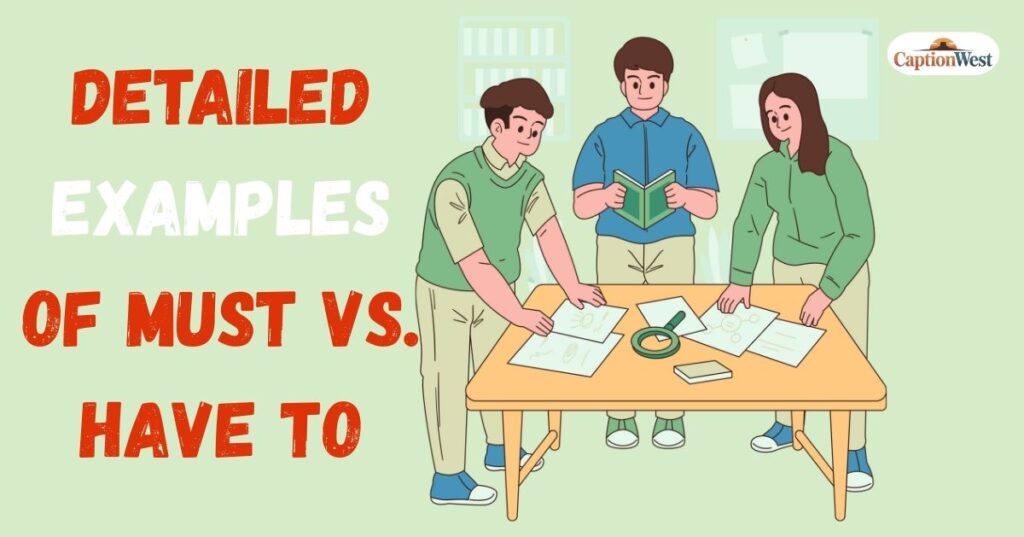English learners often get confused when deciding whether to use must or have to. Both expressions are modal verbs that show necessity, responsibility, or obligation. At first glance, they look similar, but their usage can be slightly different depending on the context, tense, and tone.
In this detailed guide, we will explore the difference between must and have to, how they are used in sentences, their meanings in different contexts, and some practical tips to help you use them correctly in everyday English.
Quick Answer: What Is the Difference Between Must and Have To?
- Must is used when the speaker personally feels something is necessary.
👉 Example: I must call my mom today. (It’s my own decision.) - Have to is used when the necessity or obligation comes from someone else, rules, or external circumstances.
👉 Example: I have to wear a uniform at work. (The company rule, not my choice.)
So the main difference between must and have to lies in whether the obligation is internal (personal) or external (imposed by others or circumstances).
Similarities Between Must and Have To
Before diving into the differences, let’s look at the similarities.
- Both express necessity, duty, or strong obligation.
- I must finish this project today.
- I have to finish this project today.
- I must finish this project today.
- Both can often replace each other in the present tense without changing the meaning much.
- Both are commonly used in spoken and written English to talk about rules, duties, and personal needs.
Key Differences Between Must and Have To

Let’s break down the difference between must and have to step by step.
1. Source of Obligation
- Must = obligation decided by the speaker.
- Have to = obligation imposed by someone else or circumstances.
✅ Examples:
- I must exercise more to stay healthy. (Personal decision)
- I have to attend the meeting because my boss told me. (External rule/obligation)
2. Formality and Tone
- Must sounds more formal and is often used in written notices, instructions, or strict rules.
- Have to sounds more natural in everyday conversation.
✅ Examples:
- Passengers must fasten their seatbelts. (Official rule – formal)
- I have to fasten my seatbelt when I drive. (Spoken – informal)
3. Usage in Tenses
- Must is mainly used in the present and sometimes the future.
- For past, future, and continuous tenses, we use have to / had to / will have to.
✅ Examples:
- Present: I must finish my homework now.
- Past: I had to finish my homework yesterday. (Not “must”)
- Future: I will have to finish my homework tomorrow.
4. Questions and Negatives
- In questions, “have to” is more common than “must.”
- In negative sentences, “must not (mustn’t)” means prohibition, while “don’t have to” means no necessity.
✅ Examples:
- Question: Do you have to work tomorrow? (Common)
Must you work tomorrow? (Rare, formal, mostly British English) - Negative:
- You mustn’t park here. (It’s forbidden / against the rules)
- You don’t have to park here. (It’s not necessary, but you can if you want)
- You mustn’t park here. (It’s forbidden / against the rules)
👉 This is one of the most important points in understanding the difference between must and have to.
Detailed Examples of Must vs. Have To

Let’s compare sentences to see how meaning changes depending on which phrase we use.
- I must remember her birthday. (I feel it’s important)
I have to remember her birthday. (Someone reminded me, or I promised) - You must wear a helmet. (Strong personal instruction, or official rule)
You have to wear a helmet. (It’s the law) - I must go now. (I personally think it’s necessary)
I have to go now. (I’m being forced by external reasons, e.g., a bus schedule)
Must vs. Have To in Real-Life Situations

✅ At School
- Teacher: You must submit your homework by Friday.
- Student: We have to submit our homework by Friday.
👉 The teacher uses “must” to give an instruction.
👉 The student uses “have to” to report the obligation given by the teacher.
✅ At Work
- Boss: Employees must arrive on time.
- Worker: I have to arrive on time because it’s company policy.
✅ In Daily Life
- I must quit smoking. (Personal resolution)
- I have to quit smoking because my doctor told me. (External advice)
Must vs. Have To: In Different Tenses
📍 Present Tense
- I must pay attention in class.
- I have to pay attention in class.
📍 Past Tense
- I had to leave early yesterday. (Correct – “must” not used in past)
📍 Future Tense
- I will have to attend the meeting tomorrow.
- I must attend the meeting tomorrow. (Possible, but less common)
👉 Remember: The past of must is always had to, and the future is will have to.
Have to vs. Have Got To
In informal English, we sometimes use have got to instead of “have to.”
Examples:
- I’ve got to go now. (Same as: I have to go now)
- She’s got to study hard for the exam. (Same as: She has to study hard)
But note: With adverbs of frequency, only have to is correct.
- I usually have to wake up early. (Correct)
- I’ve usually got to wake up early. (Incorrect)
Must vs. Have To: Summary Table
| Feature | Must | Have to |
| Source of obligation | Internal / speaker’s decision | External / imposed |
| Formality | More formal, rules, written English | More natural in speech |
| Tenses | Present, limited future | All tenses (had to, will have to) |
| Questions | Rare, formal | Common in everyday English |
| Negative form | Mustn’t = prohibition | Don’t have to = no necessity |
Common Mistakes with Must and Have To
- ❌ I must to go now.
✅ I must go now. (Never add “to” after must) - ❌ I must went there yesterday.
✅ I had to go there yesterday. (Past tense) - ❌ You don’t must do this.
✅ You don’t have to do this. (Correct negative form)
Tips for ESL Learners
- Use must when it’s your personal feeling of necessity.
- Use have to for rules, external duties, and all tenses.
- In conversation, have to is more natural.
- In official documents, must is more formal.
Read Must : Difference Between This and These: A Complete Grammar Guide
Final Thoughts
The difference between must and have to may seem small, but it can change the tone and accuracy of your sentence.
- Must = personal obligation, strong necessity, or formal instruction.
- Have to = external obligation, rules, or duties.
By practicing with real-life examples, you will quickly learn when to use must and when to use have to. Remember: in casual conversation, have to is more common, while must is stronger and more formal.

